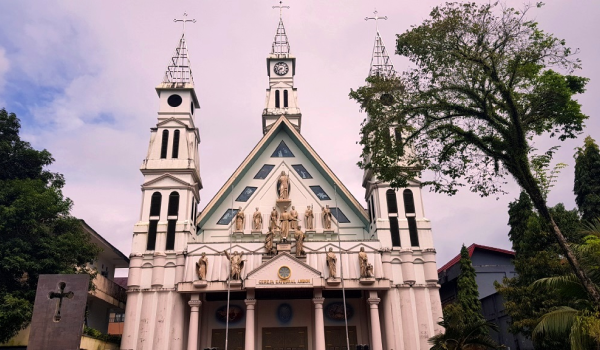
Missioners from Portugal and Spain began work in Maluku area in 1534. The first baptism was also recorded in the same year in Ternate, North Maluku. Several villagers of Mamuia on Halmahera islands accepted Catholic faith guided by Portuguese merchant Gonzalo Veloso.
The Church began to grow more significantly in 1546 with the missionary work of Portuguese missioner St. Francis Xavier. By 1558 Ambon and surrounding islands had some 10,000 Catholics.
After the Dutch took over the islands in early 17th century, Protestantism grew rapidly, limiting the influence of the Catholic Church.
On July 1, 1888, two Jesuit missioners Fathers Johannes Kusters and Johannes Booms arrived in Tual. A year later, on July 13, 1889, the head of Langgur village, near Tual, allowed Father Kusters to baptize Sakbau, a sick young girl naming her Maria Sakbau. Soon after, the girl was completely recovered and the news spread quickly helping the growth of Catholicism to other villages in Kei Islands.
The pope on Dec. 22, 1902, established the apostolic prefecture of New Guinea, the first ecclesiastically autonomous unit outside the vicariate of Batavia.
The arrival of Sacred Heart Missionaries (MSC) on Nov. 28 1903, replacing Jesuits, made the mission more effective. The first MSC missioner Father Mathias Neyens was appointed apostolic prefect.
Father Neyens worked to expand the missions extensively to north of New Guinea (1904), Kei (1906) and Tanibar Island. He occasionally visited Ambon, and also other places such as Ternate, where Dutch government did not allow Catholic missioners to establish permanent mission.
The rapid growth of the Church in Maluku helped the Vatican elevate its status to apostolic vicariate on Aug. 29, 1920, and Bishop Johannes Aerts, MSC, was appointed its first apostolic vicar. The first diocesan priest -- Father Eusebius Jamco from Kei -- was ordained in 1924.
The Japanese soldiers, who arrived on July 30 1942 in Kei Islands, executed 13 Sacred Heart missioners, including Bishop Johannes Aerts, five priests and 8 brothers in Langgur beach. Other missionaries including Dutch nuns from the Daughters of Our Lady of Sacred Heart (PBHK) were detained in concentration camps, and some of them died.
Five years later, in 1947, Father Jacobus Grent, MSC, took the seat of Bishop Aerts. He rebuilt the destroyed mission. In 1949, the name of this ecclesiastical unit was changed to vicariate apostolic of Amboina and the headquarters was moved from Langgur to Ambon in 1960.
On January 3, 1961 the hierarchy of the Church in Indonesia was officially established. At the same time, Maluku became a diocese with Bishop Grent as the first ordinary. In 1965, Bishop Andreas Peter Cornelius Sol, MSC, replaced him.
The diocese of Amboina faced a great challenge when a social conflict broke on Jan.19, 1999, in Maluku and North Maluku. About 12,000 people died and several buildings and houses were damaged. According to diocesan data, about 80 churches, five convents, and a number of schools, hospitals and several houses of Catholics were damaged.